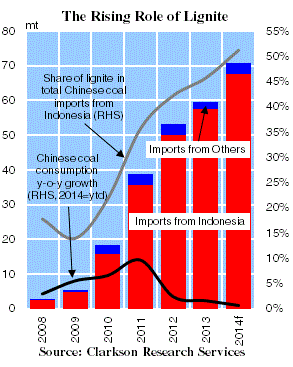Chinese Lignite Imports: Quantity over Quality?
In the first half of 2014, Chinese seaborne coal imports declined 0.4% y-o-y to 148mt, largely reflecting a 3.3% fall in imports of steam coal. Meanwhile, imports of lignite (a low-quality coal), which have risen strongly over the last few years, have remained a bright spot. In the first six months of the year, Chinese lignite imports increased by more than 20% y-o-y to 36mt.
Indonesia Dominant
Lignite has played an increasingly important role in China’s coal imports since 2009. Used largely in power generation (but also in paper mills and in the manufacture of building materials), lignite has a relatively low heat content, but due to its low quality has been attractively priced. As shown on the Graph of the Month, Chinese lignite imports have surged from 3mt in 2008 to 59mt last year.
a relatively low heat content, but due to its low quality has been attractively priced. As shown on the Graph of the Month, Chinese lignite imports have surged from 3mt in 2008 to 59mt last year.
Indonesia is the major supplier of lignite to China, accounting for 97% of China’s imports last year, with the Philippines accounting for much of the remainder. While Chinese imports of steam coal from Indonesia have also increased rapidly, the share of lignite in total coal imports from Indonesia has risen from 14% in 2009, to more than 50% in the year to date.
Driving Upwards
While favourable price dynamics have been the main factor supporting increasing steam coal and lignite imports, rapid growth in total coal consumption between 2008 and 2011 also provided some support. However, since 2012, growth in Chinese coal consumption has slowed notably, with total coal use up 0.7% y-o-y in 1H 2014. Meanwhile, the price differential between imported and domestic steam coal has narrowed, especially following several rounds of price cutting by domestic miners in July this year. As a result, imports of higher-quality steam coal (with a calorific value of over 5,000 kcal/kg) have become less competitive against domestic supplies. However, since lower-quality lignite has continued to be priced at a discount to higher-quality coal, power plants have kept costs down by continuing to use a blend of lignite and higher-quality coal in power generation.
Policy Risks
Consequently, demand for imported lignite has remained relatively firm in the year to date, despite increasing efforts by the government to restrict imports of low-quality coal. Last year, China re-imposed a 3% tax on lignite imports, but given the free trade agreement in place between China and ASEAN nations, volumes imported from Indonesia have been unaffected. Meanwhile, in July 2014, China introduced further regulations in some regions banning imports of low-quality coal transported a certain distance inland. However, a significant proportion of lignite is used in coastal power stations, many of which have geared their boilers towards using this type of coal.
So while recent efforts to restrict low-quality coal imports have not yet had a notable effect, regulatory trends may well limit lignite import growth in the longer-term. Yet in the short-term, favourable pricing and the current dependence of power plants on low-quality coal suggest that China’s lignite imports from Indonesia will continue to remain firm.
HEADLINES
- Do shipping markets want Biden or Trump for the win?
- All 18 crew safe after fire on Japanese-owned tanker off Singapore
- Singapore launching $44m co-investment initiative for maritime tech start-ups
- Cosco debuts Global Shipping Industry Chain Cooperation Initiative
- US warns of more shipping sanctions
- China continues seaport consolidation as Dalian offer goes unconditional